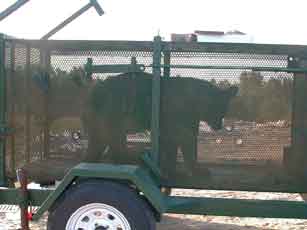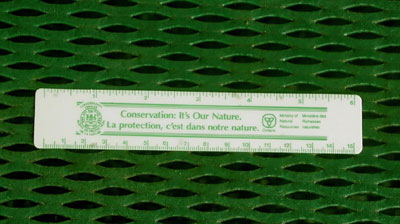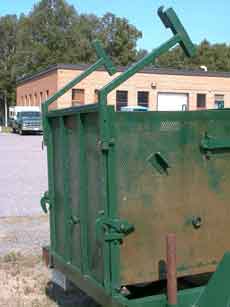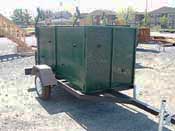
Due to humane concerns, the Ontario Ministry of Natural Resources policy is to only use child/bear-friendly traps and family units must be live trapped and released together.
Live trapping and relocating conflict black bears has been a common practice across North America for decades. During this period, the traps were designed and constructed without quality control and standard technical specifications. Consequently, traps varied in shape, triggering mechanism, construction materials and workmanship. Traps were commonly constructed from large culverts with heavy spring loaded doors. The triggering mechanism consisted of complex pulley systems, wide meshed grating, exposed guy wires and large treadle pedal inside the trap. Although functional, these designs were fraught with problems, including frequent malfunctions of the trigger pedal, injuries to bears paws, claws and teeth, cumbersome handling of the sedated bears and potential injury to children or bear cubs standing in the doorway when the trap is triggered.
A child/bear-friendly trap was designed that improved upon these problems:

Photo Credit: OMNR. Detail of wire mesh used to humanely live trap a bear.
Design Parameters:
The trap was designed to include the following features:
– simplified triggering mechanisms
– injury free see-through meshing
– front and back access
– unobstructed interior
– cool interior climate
– spring free, soft impact door closure
Trap Description:
Mounted on its own trailer, the trap measures 1 m x 1 m x 2.5 m (40 in. x 40 in. x 8 ft) and is constructed from 14 gauge plate steel for the top and bottom and 1.5 in. x 13 flat expanded mesh for the sides. The solid plates protect the bears from the sun and rain and permit easy cleaning. The side mesh is small enough to prevent the bears from catching their claws and canines in the openings, while allowing the handlers to see the bear at all times. Numerous 4.5 cm (1 ¾ in.) holes at different heights in the side mesh permit easy access to the bears for immobilization.
 A door at each end significantly improves the removal of tranquilized animals and allows the floor to be cleaned with a power washer. The trap is baited via the front door avoiding the need to climb into the cage.
A door at each end significantly improves the removal of tranquilized animals and allows the floor to be cleaned with a power washer. The trap is baited via the front door avoiding the need to climb into the cage.
The back door is hinged at the top. Counter-weights are used to allow the door to rest at a 45 degree angle when unlatched. When the door is raised to its set position, a returning moment prevails causing it to accelerate downward when released. Once passed its resting position, a counter moment overrides, causing the door to decelerate before latching to the back frame. The result is a softly locking door that eliminates any potential injury to bears or people. Bears can be later safely released from inside the tow vehicle by pulling the ropes attached to the latch hooks. Once free, the door returns to its 45 degree resting position, creating an opening for the bear.
A stainless steel cable joined to the trigger level that holds the door in the set position is guided to the front of the cage through a 3.8 cm (1.5 in.) pipe conduit welded to the outside of the side mesh. A bait bag is attached to the front end of the cable. Pulling on the bait bag unlatches the back door. When the bear enters the cage, it must move all the way to the front in order to reach the bait. This greatly improves the trap’s effectiveness by reducing the incidence of startled bears escaping before the door closes. Bait scent propagation is enhanced by positioning it against the front and side meshes.
 Conclusion:
Conclusion:
The improved bear trap has been field-tested since 2000 throughout northern Ontario, where several hundred bears have been successfully captured with no reported injuries to the animals or people. The demand for this new design is steadily increasing. Please contact Ivan or Josef if you would like detailed plans or assistance in building a trap.
Start building….. download specs.
Need more help? Contact:
Josef Hamr – email: JOSEF.HAMR@cambriancollege.ca
Engineering Technology and Environmental Studies
Cambrian College of Applied Arts and Technology
1440 Barrydowne Road, Sudbury, Ontario P3A 3V8, Canada
Phone: (705) 566-8101 Fax: (705) 524-9582
